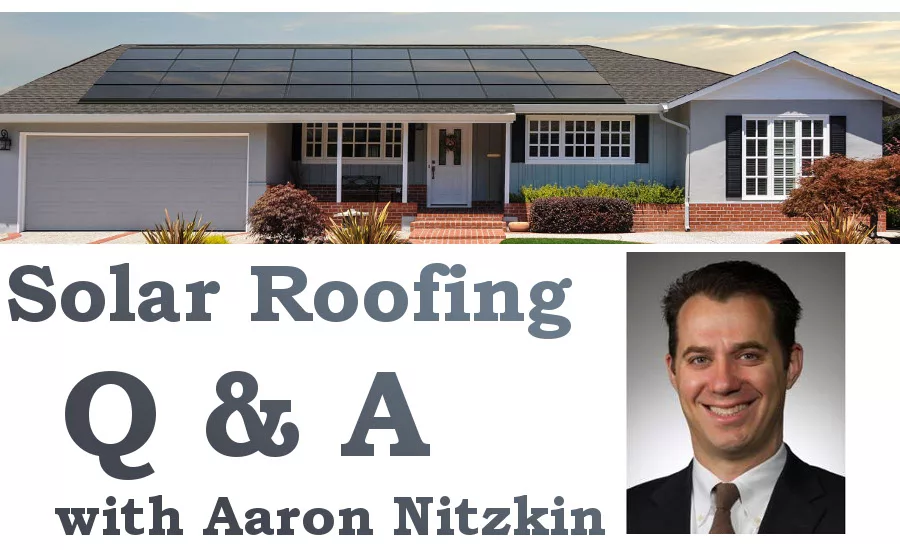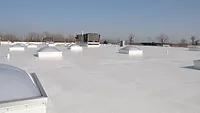Q&A with Aaron Nitzkin: Solar Energy's Steady Growth in Recent Years Shows No Signs of Slowing Down

Last year was a big one for the solar roofing industry with the renewal of federal tax credits and the announcement of Tesla’s ‘solar shingle.’ And while many are excited about the prospects of solar, there are many roofing contractors still leery of incorporating it into their business model for reasons, including cost and regulatory concerns. Roofing Contractor recently asked Aaron Nitzkin, founder and CEO of Solar Roof Dynamics, about the benefits of incorporating the emerging trend into their roofing business and what they should be prepared for.
Currently, how big is the solar industry?
Today, solar represents the fastest growing energy source in the United States. While it still represents less than one percent of the total energy produced in the U.S., the industry employs 209,000 Americans (versus the coal industry that employs 110,000 people but represents approximately 30 percent of our energy production). By 2021, the Solar Energy Industry Association estimates that the number of people working in the U.S. solar industry will increase 70 percent to 360,000. As for installed capacity, an estimated 14 Gigawatts of solar energy was commissioned in the U.S. in 2016, which represents an 85 percent increase over 2015. If you assume an average panel size of 285 watts, this translates into over 49 million solar panels installed in the U.S. last year.
Are roofing contractors getting into solar?
More and more roofing contractors are realizing that they’re well positioned to capitalize on the solar boom. The National Roofing Contractors Association (NRCA) has a PV (Photovoltaic) task force that’s working on how best to position and support roofing contractors who want to add solar into their businesses. Roofing contractors can also get certified through NRCA’s Roof Integrated Solar Energy (RISE) certification program. To some degree, the level of roofing contractor involvement in solar mirrors the geographical market penetration of solar. California continues to represent the largest solar market in the country, and as expected, many roofing contractors throughout the state have added “& Solar” to their company names. These contractors are actively promoting solar as a roofing upsell. Other leading states with roofing contractors who offer solar include New York, New Jersey, Maryland, Massachusetts, and Colorado.
Solar Energy Related Exhibitors:
DERBIGUM Americas, Inc. at Booth 339
ATAS International, Inc. at Booth 450
S-5! at Booth 617
Kennedy Skylights at Booth 1663
Air Vent, Inc. at Booth 1815
Lifting Equipment Solutions, LLC at Booth 2066
VELUX America LLC. at Booth 2445
Reimann & Georger Corp./RGC at Booth 1350
Englert, Inc. at Booth 1423
Wausau Tile, Inc. at Booth 2140
Roof Integrated Solar Energy at Booth 1741
AceClamp/PMC Industries at Booth 263
Eco Chief Products at Booth 766
What ways can a roofing contractor profit from solar?
Roofing contractors can get involved in and profit from the solar industry in numerous ways. At the most limited level, they can partner with solar installers to perform the roof penetrations and flashings, while agreeing to pass leads to one another (i.e. roofing leads are passed from the solar contractor to the roofing contractor and solar leads are passed from the roofing contractor to the solar contractor). For those that are strong on the installation process but not in sales, they can partner with solar sales companies and/or provide labor-only installation services to solar companies. Finally, for those that believe that solar is here to stay and want to become a full-fledged solar and roofing contractor, there are companies that can assist them in making this transition.
I heard Elon Musk’s (Tesla/SolarCity) announcement about launching a solar roof shingle. What impact will this have on roofing contractors?
In conjunction with Elon Musk seeking approval from Tesla shareholders for the acquisition of SolarCity in late 2016, he announced a new product line of roofing integrated solar shingles and tiles. Tesla has resisted requests to provide additional details about the products, and many in both the roofing and solar industries are skeptical that the products shown will come to market any time soon. Some sources have shared with me that when the product comes to market, Tesla plans to do all the installations themselves, in essence becoming a roofing contractor. This will undoubtedly bring a discussion to the forefront about the role of the roofing contractor and roof integrity. It also highlights a possible reemergence of the solar roof shingle/tile product category, which is further supported by GAF, who in January launched a new roof-integrated solar product for composition shingle roofs.
How big will the market be for rooftop solar in 2017 and beyond?
The U.S. solar market has been on a tear since 2011, with the residential solar market growing over 50 percent year over year. Going forward, the growth in the residential and commercial market segments is expected to continue, albeit a bit more modestly, with expectations of 15 percent annual growth for the next five years. While this may sound like slow growth relative to the past few years, this equates to over 550,000 residential solar systems alone expected to be installed in 2017 and over 3.6 million residential systems over the next five years. According to GTM (Greentech Media) Research, while 87 percent of all solar installations in 2015 took place in 10 states (California, North Carolina, Nevada, Massachusettes, New York, Arizona, Utah, Georgia, Texas and New Jersey), solar penetration is rapidly expanding into new markets. In 2016, there was significant growth in a number of new markets including Colorado, New Mexico and Oregon.
Looking for a reprint of this article?
From high-res PDFs to custom plaques, order your copy today!






